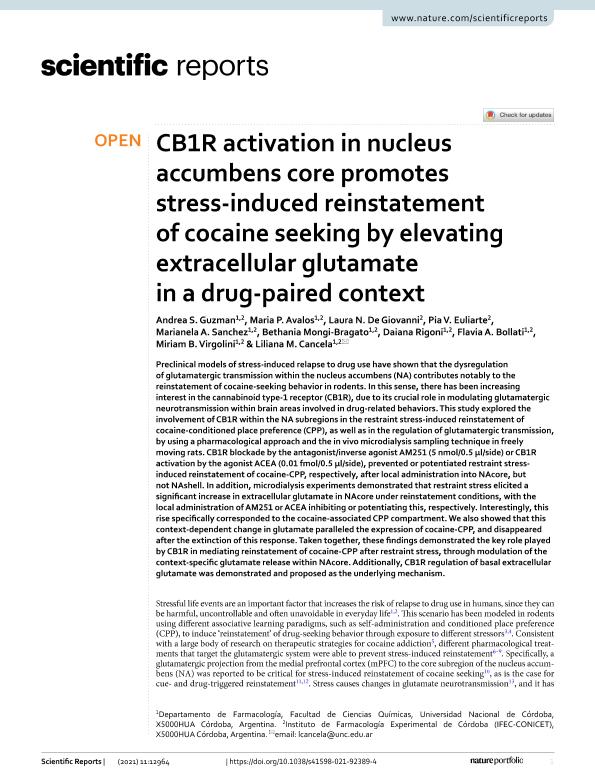Artículo
CB1R activation in nucleus accumbens core promotes stress-induced reinstatement of cocaine seeking by elevating extracellular glutamate in a drug-paired context
Guzman, Andrea Susana ; Avalos, Maria Paula
; Avalos, Maria Paula ; de Giovanni, Laura Noemi
; de Giovanni, Laura Noemi ; Euliarte, Pía Valentina; Sanchez, Marianela Adela
; Euliarte, Pía Valentina; Sanchez, Marianela Adela ; Mongi Bragato, Bethania del Carmen
; Mongi Bragato, Bethania del Carmen ; Rigoni, Daiana
; Rigoni, Daiana ; Bollati, Flavia Andrea
; Bollati, Flavia Andrea ; Virgolini, Miriam Beatriz
; Virgolini, Miriam Beatriz ; Cancela, Liliana Marina
; Cancela, Liliana Marina
 ; Avalos, Maria Paula
; Avalos, Maria Paula ; de Giovanni, Laura Noemi
; de Giovanni, Laura Noemi ; Euliarte, Pía Valentina; Sanchez, Marianela Adela
; Euliarte, Pía Valentina; Sanchez, Marianela Adela ; Mongi Bragato, Bethania del Carmen
; Mongi Bragato, Bethania del Carmen ; Rigoni, Daiana
; Rigoni, Daiana ; Bollati, Flavia Andrea
; Bollati, Flavia Andrea ; Virgolini, Miriam Beatriz
; Virgolini, Miriam Beatriz ; Cancela, Liliana Marina
; Cancela, Liliana Marina
Fecha de publicación:
12/2021
Editorial:
Nature Publishing Group
Revista:
Scientific Reports
e-ISSN:
2045-2322
Idioma:
Inglés
Tipo de recurso:
Artículo publicado
Clasificación temática:
Resumen
Preclinical models of stress-induced relapse to drug use have shown that the dysregulation of glutamatergic transmission within the nucleus accumbens (NA) contributes notably to the reinstatement of cocaine-seeking behavior in rodents. In this sense, there has been increasing interest in the cannabinoid type-1 receptor (CB1R), due to its crucial role in modulating glutamatergic neurotransmission within brain areas involved in drug-related behaviors. This study explored the involvement of CB1R within the NA subregions in the restraint stress-induced reinstatement of cocaine-conditioned place preference (CPP), as well as in the regulation of glutamatergic transmission, by using a pharmacological approach and the in vivo microdialysis sampling technique in freely moving rats. CB1R blockade by the antagonist/inverse agonist AM251 (5 nmol/0.5 μl/side) or CB1R activation by the agonist ACEA (0.01 fmol/0.5 μl/side), prevented or potentiated restraint stress-induced reinstatement of cocaine-CPP, respectively, after local administration into NAcore, but not NAshell. In addition, microdialysis experiments demonstrated that restraint stress elicited a significant increase in extracellular glutamate in NAcore under reinstatement conditions, with the local administration of AM251 or ACEA inhibiting or potentiating this, respectively. Interestingly, this rise specifically corresponded to the cocaine-associated CPP compartment. We also showed that this context-dependent change in glutamate paralleled the expression of cocaine-CPP, and disappeared after the extinction of this response. Taken together, these findings demonstrated the key role played by CB1R in mediating reinstatement of cocaine-CPP after restraint stress, through modulation of the context-specific glutamate release within NAcore. Additionally, CB1R regulation of basal extracellular glutamate was demonstrated and proposed as the underlying mechanism.
Palabras clave:
GLUTAMATE
,
STRESS
,
CB1 RECEPTORS
,
COCAINE
Archivos asociados
Licencia
Identificadores
Colecciones
Articulos(IFEC)
Articulos de INST. DE FARMACOLOGIA EXPERIMENTAL DE CORDOBA
Articulos de INST. DE FARMACOLOGIA EXPERIMENTAL DE CORDOBA
Citación
Guzman, Andrea Susana; Avalos, Maria Paula; de Giovanni, Laura Noemi; Euliarte, Pía Valentina; Sanchez, Marianela Adela; et al.; CB1R activation in nucleus accumbens core promotes stress-induced reinstatement of cocaine seeking by elevating extracellular glutamate in a drug-paired context; Nature Publishing Group; Scientific Reports; 11; 1; 12-2021; 1-18
Compartir
Altmétricas



